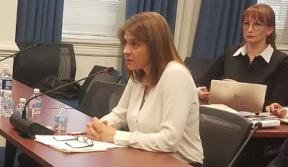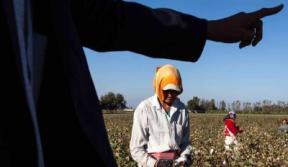Roughly one out of every five adults in Uzbekistan was coerced into picking cotton during the just-completed harvest season, according to a November 14 statement distributed by the Cotton Campaign, an activist coalition seeking to put an end to the government’s use of forced labor.
Cotton Campaign researchers estimate that about 4 million adults, many of them state employees, were pressed into gathering cotton this harvest season in Uzbekistan. According to the CIA’s most recent estimate, Uzbekistan has an overall population of almost 29 million, a quarter of which is under the age of 14. An additional 21 percent is between the ages of 15 and 24. Those estimates, along with the Cotton Campaign figure, would suggest that at least 20 percent of the over-18 population spent time in the cotton fields this fall against their will.
The Uzbek government has faced international condemnation for its widespread use of forced child labor in cotton harvesting. In recent years, however, authorities have shifted the burden, reducing the number of children compelled to leave school and pick cotton, and replacing them with fresh legions of adults.
“Reducing the number of children in the fields by forcing even more adults to work against their will is not sufficient. The government needs to dismantle the forced labor system,” a Cotton Campaign statement quoted Umida Niyazova, the director of the Uzbek-German Forum for Human Rights, which prepared a preliminary report on the harvest.
The government set manpower quotas ranging from 30 percent to 60 percent of staff for public-sector institutions, including schools, hospitals and local government agencies, the watchdog group said. Parents of school children in some locations also came under pressure to pick cotton. The quotas were significantly higher in 2014 than they were for last year’s harvest. Uzbekistan is the world’s fifth largest cotton producer.
The Cotton Campaign documented 17 deaths during the 2014 harvest season that it says are directly related to the government’s forced labor practices, including two small children who died in a house fire after being left alone by their mother, who was forced to go pick cotton, and could not arrange for anyone to care for them. The group documented 11 forced labor-related deaths during the 2013 harvest.
While the use of child labor has declined since 2012, the Cotton Campaign statement said the practice has not been eradicated. It documented cases of high school students being sent into the fields in the Kashkadarya, Jizzakh and Samarkand regions.
Meanwhile, a recent report examining money flows in Uzbekistan’s cotton sector shows that it is not only intentionally inefficient, it is rigged so that a few at the very top of the country’s power structure reap the bulk of the profits, while most farmers are shackled with grinding debt.
“Each year, the government issues mandatory targets for cotton and grain production to local officials, who in turn assign quotas to individual agricultural producers,” the report states. “For failure to fulfill their targets, local hokims risk losing their positions and farmers are subject to a range of economic and administrative sanctions.”
The report details how farmers must interact with government-controlled monopolies to obtain loans, supplies and equipment needed for planting and harvesting. It also traces how farmers are forced to sell their cotton to state entities at artificially low, government-mandated prices.
“Farmers are largely unable to make enough profit on cotton production to allow them to save, invest or even pay a fair wage to farm workers,” said the report, titled Hidden in Plain Sight: The Political Economy of the Cotton Industry in Uzbekistan.
Roughly one out of every five adults in Uzbekistan was coerced into picking cotton during the just-completed harvest season, according to a November 14 statement distributed by the Cotton Campaign, an activist coalition seeking to put an end to the government’s use of forced labor.
Cotton Campaign researchers estimate that about 4 million adults, many of them state employees, were pressed into gathering cotton this harvest season in Uzbekistan. According to the CIA’s most recent estimate, Uzbekistan has an overall population of almost 29 million, a quarter of which is under the age of 14. An additional 21 percent is between the ages of 15 and 24. Those estimates, along with the Cotton Campaign figure, would suggest that at least 20 percent of the over-18 population spent time in the cotton fields this fall against their will.
The Uzbek government has faced international condemnation for its widespread use of forced child labor in cotton harvesting. In recent years, however, authorities have shifted the burden, reducing the number of children compelled to leave school and pick cotton, and replacing them with fresh legions of adults.
“Reducing the number of children in the fields by forcing even more adults to work against their will is not sufficient. The government needs to dismantle the forced labor system,” a Cotton Campaign statement quoted Umida Niyazova, the director of the Uzbek-German Forum for Human Rights, which prepared a preliminary report on the harvest.
The government set manpower quotas ranging from 30 percent to 60 percent of staff for public-sector institutions, including schools, hospitals and local government agencies, the watchdog group said. Parents of school children in some locations also came under pressure to pick cotton. The quotas were significantly higher in 2014 than they were for last year’s harvest. Uzbekistan is the world’s fifth largest cotton producer.
The Cotton Campaign documented 17 deaths during the 2014 harvest season that it says are directly related to the government’s forced labor practices, including two small children who died in a house fire after being left alone by their mother, who was forced to go pick cotton, and could not arrange for anyone to care for them. The group documented 11 forced labor-related deaths during the 2013 harvest.
While the use of child labor has declined since 2012, the Cotton Campaign statement said the practice has not been eradicated. It documented cases of high school students being sent into the fields in the Kashkadarya, Jizzakh and Samarkand regions.
Meanwhile, a recent report examining money flows in Uzbekistan’s cotton sector shows that it is not only intentionally inefficient, it is rigged so that a few at the very top of the country’s power structure reap the bulk of the profits, while most farmers are shackled with grinding debt.
“Each year, the government issues mandatory targets for cotton and grain production to local officials, who in turn assign quotas to individual agricultural producers,” the report states. “For failure to fulfill their targets, local hokims risk losing their positions and farmers are subject to a range of economic and administrative sanctions.”
The report details how farmers must interact with government-controlled monopolies to obtain loans, supplies and equipment needed for planting and harvesting. It also traces how farmers are forced to sell their cotton to state entities at artificially low, government-mandated prices.
“Farmers are largely unable to make enough profit on cotton production to allow them to save, invest or even pay a fair wage to farm workers,” said the report, titled Hidden in Plain Sight: The Political Economy of the Cotton Industry in Uzbekistan.
The report was published by the Eurasia Program of the New York-based Open Society Foundations (OSF). EurasiaNet.org also operates under OSF’s auspices.
.
Eurasianet
11/14/2014

